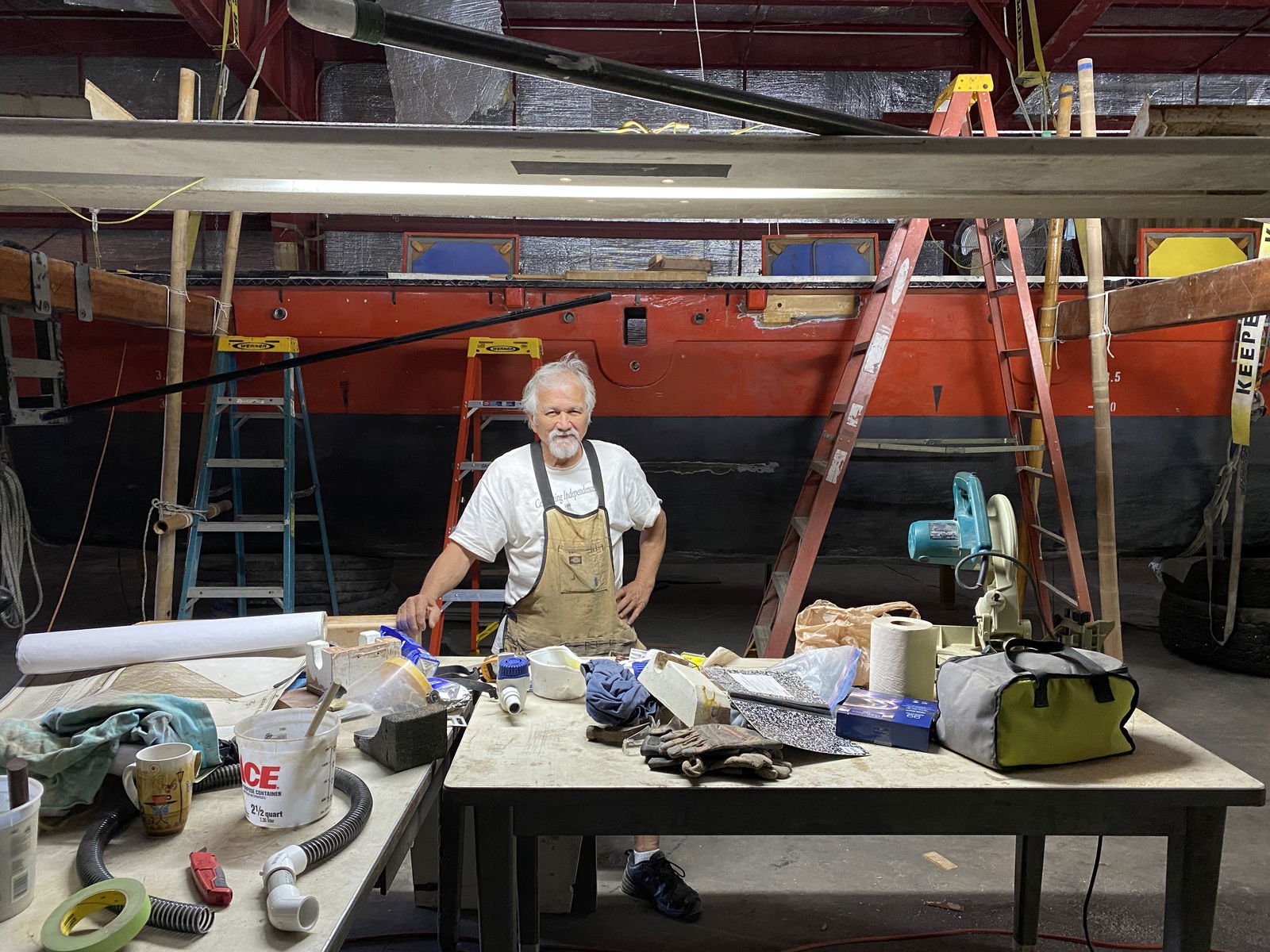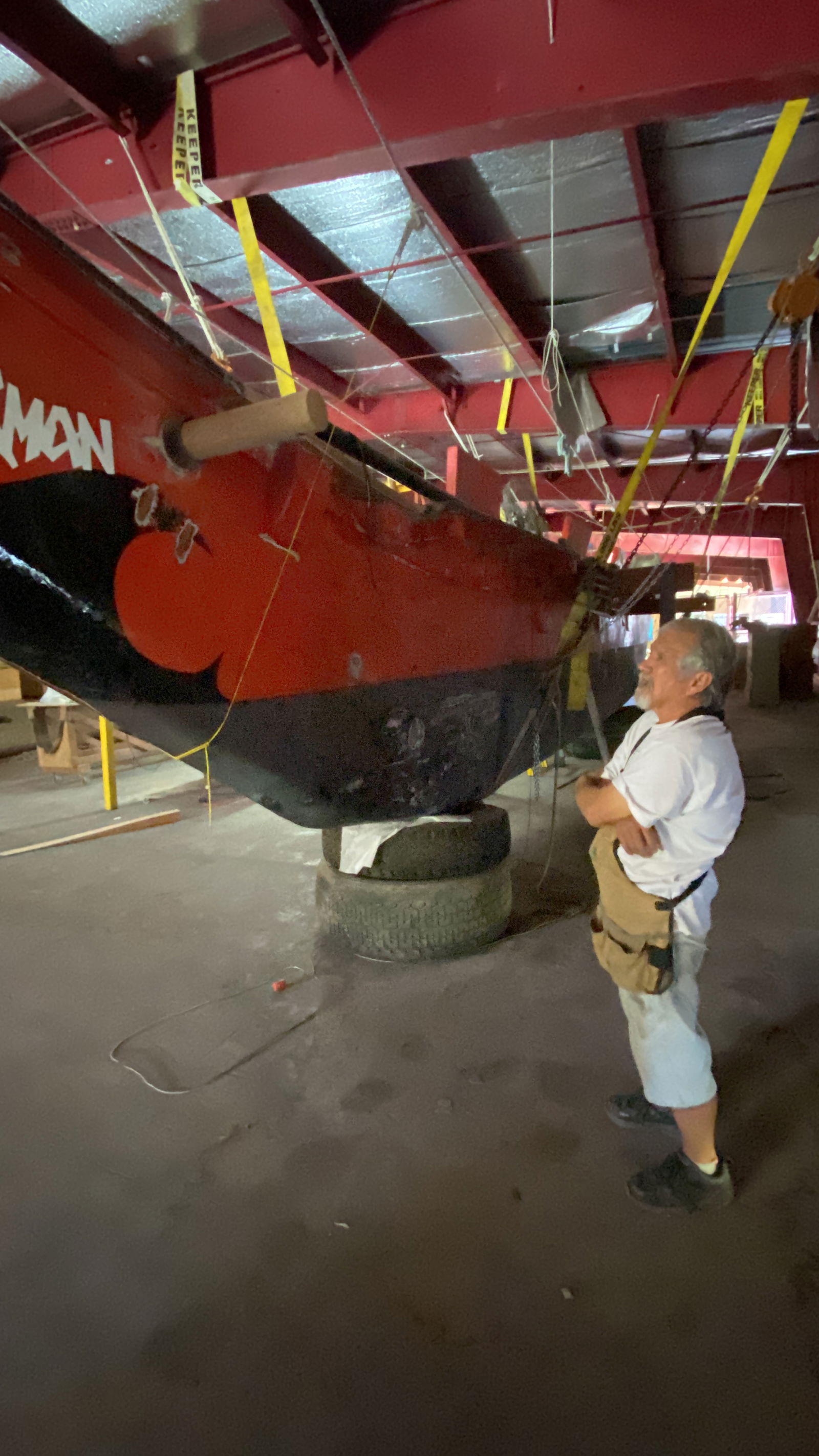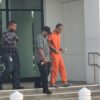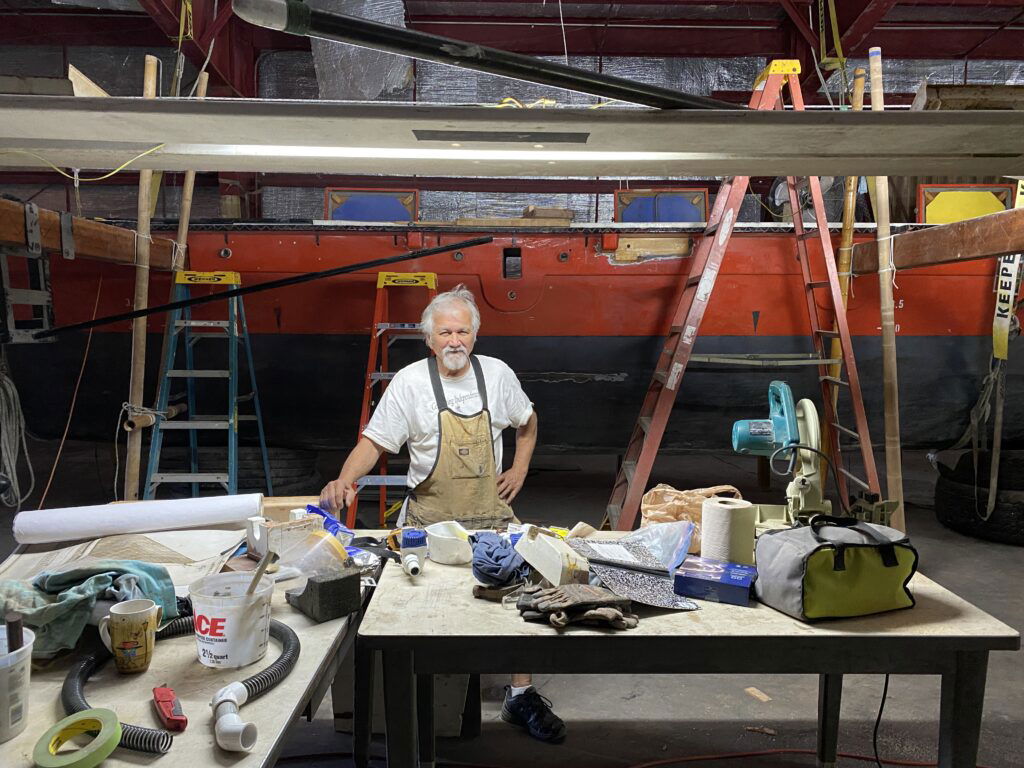
Mario Borja is an aerospace engineer who, in his retirement, has dedicated himself to building and maintaining Che’lu, a member of 500 Sails fleet of traditional Chamorro canoes.

Mario Borja would like to see the development of ethnomathematics curriculum centered on the sakman in the Marianas. He used the Anson Drawing, which he holds in his hands, to create Che’lu.

Mario Borja believes Che’lu could be ready for the waters right off of Saipan as early as February. Most of Che’lu’s maintainance has not been extensive. Photo shows Borja inspecting some minor work he’s done to touch up Che’lu’s gunwale.

Mario Borja poses in front of Che’lu, a 47-foot-long traditional Chamorro vessel made from California Redwood.
AN engineer who in 2011 helped bring to life Che’lu, a 47-foot-long Chamorro canoe, believes it could be sailing in the waters of Saipan by early February.
Mario “Sakman” Borja returned to Saipan on Saturday, Jan. 20 in order to continue maintenance on Che’lu, which is Chamorro for sibling.
Borja is routinely on island for months at a time, working on vessel repairs at the 500 Sails Boatyard in Lower Base. Last year, he spent a total of six months here, staying three months at a time before going back to his home in San Diego, California.
He spoke to the Variety during a break from his maintenance work.
“We spent so much money and so much time invested in this thing so we want to keep it for another 30 to 40 years,” Borja said. “The only way to do it is to keep on top of maintenance.”
Borja said Che’lu was carved from a massive California Redwood log, and must be protected from termite damage. So far, Borja said, “no mold, no gå’ga, no termites, no worms or nothing, thank God.”
At one point, Che’lu was based in San Diego, sailing up and down San Diego Bay.
It was transported to Guam to take part in the 2016 Festival of the Pacific Arts and Culture, where it was featured in the parade of canoes that marked the festival’s opening.
Che’lu would be on Guam until December 2019, when 500 Sails acquired her as part of a fleet of traditional sailing vessels.
“With that first 10 years in the water and all its activity, it took a beating especially on the gunwales,” Borja said, adding that he’s been able to fix the parts of the boat he was concerned with.
A gunwale is the top portion of a boat’s hull.
He said aside from routine maintenance, Che’lu will also likely need special marine paint on its lower hull to prevent barnacle growth.
But maintenance aside, Borja is looking for the next generation of engineers to join him in the effort to keep traditional Chamorro vessels on the water.
“There’s so much to learn on a canoe and I’m looking for collaborators,” Borja said. “One set of eyes isn’t sufficient. We need the perspective of many sets of eyes to look at the same thing and interpret it their own way. I can interpret it one way, but another person may have a different opinion. Collaboration is needed,” he said, adding that he wants to build interest in ethnomathematics at the University of Guam, Northern Marianas College, Guam Community College, and the University of California at San Diego.
Borja said ethnomathematics is “culturally based mathematics.”
Borja holds a bachelor’s degree in aerospace, aeronautical, and astronautical/space engineering from the University of Texas at Austin; a master of science degree in engineering/industrial management; and a master of science degree in aerospace, aeronautical, and astronautical/space engineering from the U.S. Air Force Institute of Technology.
He also served in the U.S. Air Force and worked on avionics and space surveillance.
To create future canoe builders, he wants to firmly establish students in math that is relevant to them. He also wants to incorporate Chamorro canoes in the process.
“I want to approach this subject [ethnomathematics] with a focus on the sakman [a traditional 40-foot-long Chamorro canoe]. If you look at the sakman it’s inundated with triangles,” Borja said. “You look deeper and you’ll find so many affinities with math, form, structure.”
Borja pointed to the Anson Drawing, which was a sketch taken from the 1742 voyage undertaken by British Admiral George Anson. While Anson was off the coast of Tinian, he captured a Chamorro sailing canoe, and an officer on board, Lieutenant Peircy Brett, made a sketch of it.
“This is a wonderful engineering drawing,” Borja said of the Anson Drawing, which he used in creating Che’lu.
“Where else can you find a front view, side view, and a top view along with that scaling data? It’s powerful. It’s with this scaling data that we’re able to do what we did,” Borja said.
Borja said at UCSD, he has taught various canoe-building skills and conducted workshops.
He remains an energetic supporter of traditional vessels and the revival of Chamorro seafaring and boat building. He wants to see Che’lu and other Chamorro sailing vessels preserved for the new generation. For him, it’s all about the “glory of the canoe.”
“It doesn’t belong to me or 500 Sails. It belongs to us. So let’s put our fingers in and our minds together and seek this thing out. To me it’s our sacred duty. Our ancestors never wrote, we can. Our ancestors never documented this thing in media, we can.”











